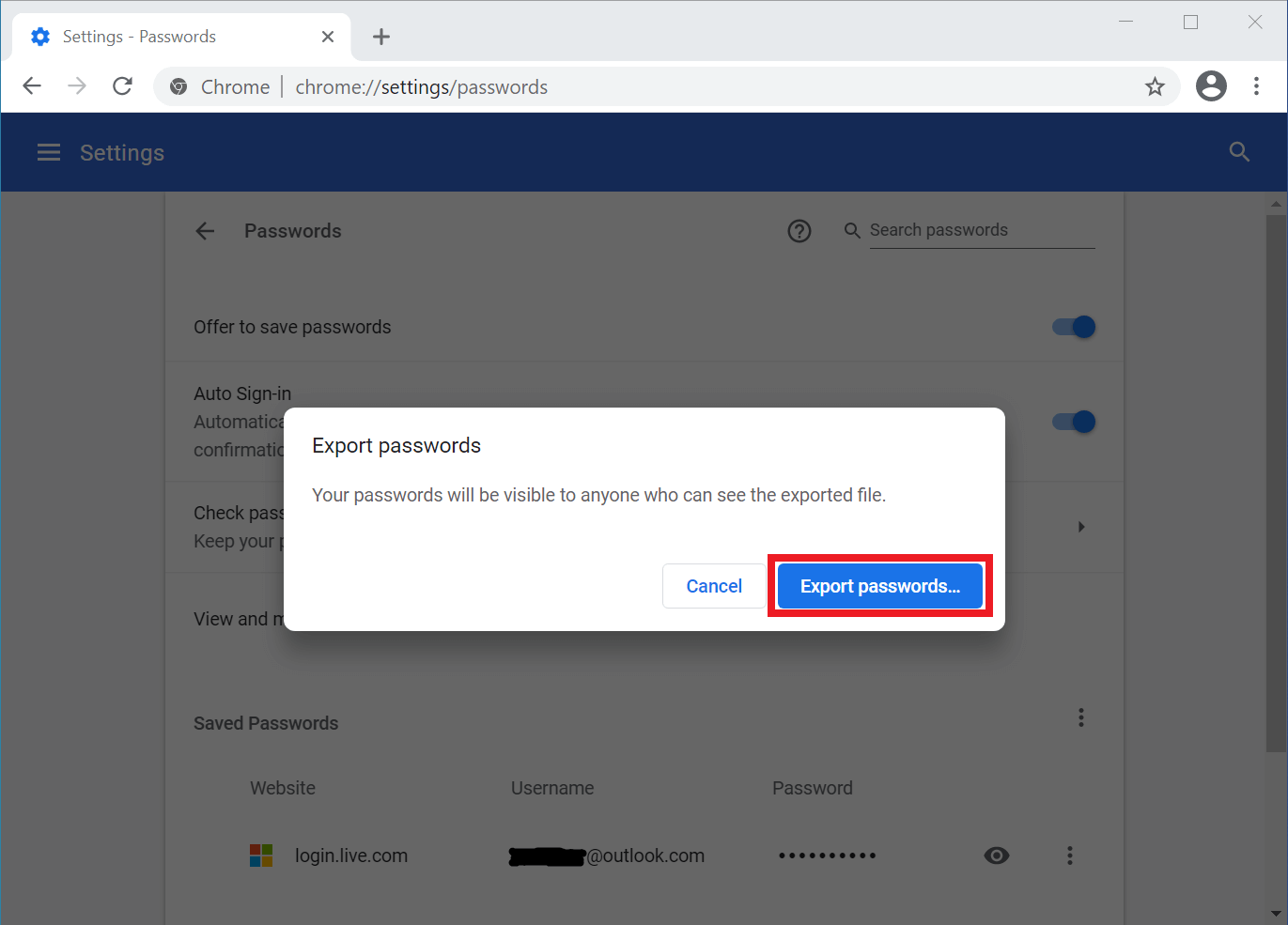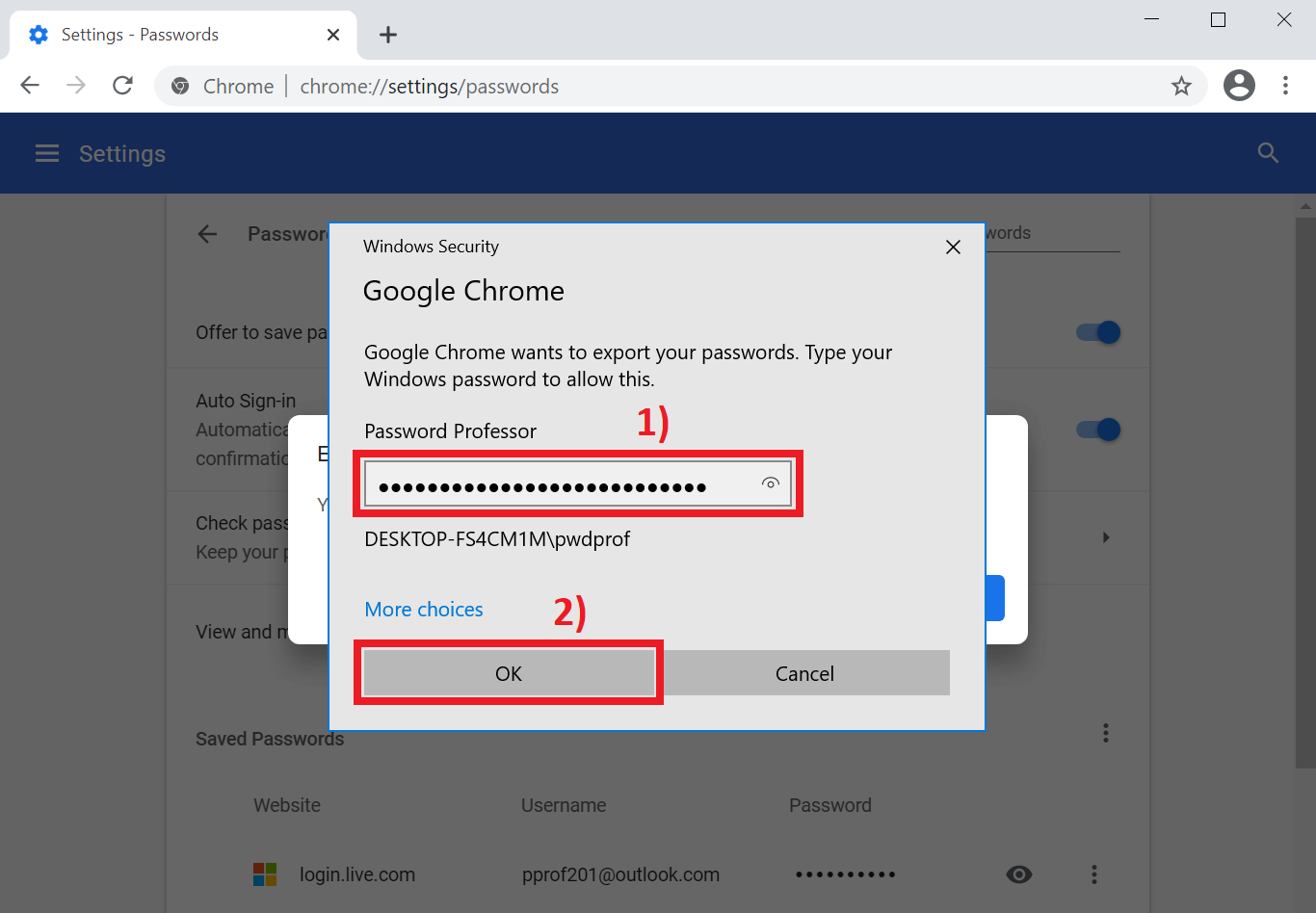- Home
- Passwords saved in Chrome
- Export Chrome Passwords
Export Chrome passwords
Learn how to put all your Chrome passwords in a comma-delimited (CSV) file you can open with Excel or similar program.
You would like to export Chrome passwords to back them up, move them from one computer to another, or review them all at once in an Excel spreadsheet rather than viewing them one by one inside Chrome itself.
If your primary web browser is Chrome you are probably letting it store your passwords. Because Chrome knows your passwords, it logs you into websites automatically. After some time, you don't even know what your passwords are, which means you have one less thing to worry about.
It is always a good idea to have a backup of your passwords. Computers tend to die suddenly and unexpectedly, often just when you are in the middle of doing something important.
Or maybe you want to view all passwords that are saved in Chrome. Perhaps some of your passwords are weak or old (or both) and you are considering changing them.
While viewing passwords in Chrome is a good way to take a look at an occasional password when you need to recall what it is, when you need to work with multiple passwords it is easier to open them in Microsoft Excel or similar software that can view comma-delimited (CSV) files.
If you don't have Microsoft Excel, LibreOffice Calc is a good (and free) alternative.
If you are changing computers and want to transfer your passwords saved in Chrome, you can export Chrome passwords on the old computer, copy them over to the new computer, and import them back to Chrome there. Although this can also be done with Chrome sync, maybe you're not using it or prefer to export and import Chrome passwords yourself.
How to export Chrome passwords
To export Chrome passwords follow these seven simple steps.
1) Start Google Chrome web browser
Start Chrome on your computer.
 Open Google Chrome
Open Google Chrome2) Open Chrome password settings
At the top right of Chrome, click on the Profile icon (Step 1).
Then click on the Passwords icon (Step 2).
 Open Chrome password settings
Open Chrome password settings3) Click on three vertical dots
You are now in the password settings section of the Chrome configuration. Next to "Saved Passwords", click on the three vertical dots.
 Click on three vertical dots
Click on three vertical dots4) Select "Export passwords..." from the pull-down menu
After clicking on the three vertical dots, a pull-down menu will open. Select "Export passwords...".
 Select "Export passwords..." from the pull-down menu
Select "Export passwords..." from the pull-down menu5) Click on "Export passwords..."
You will see a warning that says:
"Your passwords will be visible to anyone who can see the exported file."
Once you export Chrome passwords to an Excel (CSV) file, anyone who has access to that file on your computer can view your passwords. This is because your passwords will be stored in plain text and are not be encrypted.
You should minimize the time your exported passwords are stored on your computer. View them or back them up, and then delete the file.
 Click on "Export passwords..."
Click on "Export passwords..."6) Type your computer password
Your computer password is the only security mechanism Chrome has to protect your passwords. Anyone who has your computer password can export Chrome passwords that belong to you.
Enter your computer password to continue.
 Type your computer password
Type your computer password7) Save exported Chrome passwords
Chrome will export your passwords to a file on your computer called "Chrome Passwords.csv". You can change the name of the file, as well as the destination folder to which the file will be saved.
The format of the file will be CSV, or comma-separated values. You cannot change this while saving the file on your computer, but once you open it in Microsoft Excel, LibreOffice Calc or a program of your choice, you can re-save it in another format. For example, if you use Microsoft Excel to open the file, you can save it (File -> Save As) as Excel Workbook (.xlsx).
 Save exported Chrome passwords
Save exported Chrome passwordsOpen file where you saved Chrome passwords
Your Chrome passwords are now saved on your computer in a comma-delimited (CSV) file. You can open the file with Microsoft Excel or LibreOffice Calc (or Apple Numbers on Mac) and view your passwords.
 Double-click to open Chrome Passwords.csv
Double-click to open Chrome Passwords.csvThis is what the file looks like
When you open the Chrome Passwords.csv file you will see four fields:
- Column A: the name of the website
- Column B: the website URL (link)
- Column C: your username
- Column D: your password
 Chrome Passwords.csv
Chrome Passwords.csvIt is important to realize that your passwords stored this way on your computer are at risk. Because the CSV file is not encrypted (and even if it is, Excel file encryption is easy to break) if someone gets a hold of it they can read your passwords.
In addition, your web browser has access to your computer files, and web browsers are not very secure themselves. So it is not unimaginable that any file, including this passwords file, could get uploaded from your computer to password thief's computer.
Is there a better way to store passwords?
Indeed, there is a better way that is more convenient and secure. Have you considered using a password manager?
- Home
- Passwords saved in Chrome
- Export Chrome Passwords